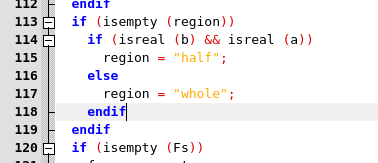|
| From: | Augustin Lefèvre |
| Subject: | Re: freqz behavior |
| Date: | Fri, 19 Jun 2020 09:28:19 +0200 |
| User-agent: | Mozilla/5.0 (X11; Linux x86_64; rv:68.0) Gecko/20100101 Thunderbird/68.8.0 |

% Poles 0.9 exp(+-j pi/4), Zero at -1
subplot(2, 1, 1)
theta_r = [-1 1]*pi/4;
a = poly(0.9*exp(j*theta_r));
b = poly(-1);
[H1 W1] = freqz(b, a);
plot(W1/pi, abs(H1))
% No poles. Zeros at angles that are multiples of pi/4 on unit circle except at angle 0
subplot(2, 1, 2)
theta_r = [-3:-1 1:4]*pi/4;
a = 1;
b = poly(exp(j*theta_r));
[H2 W2] = freqz(b, a);
plot(W2/pi, abs(H2))
| [Prev in Thread] | Current Thread | [Next in Thread] |